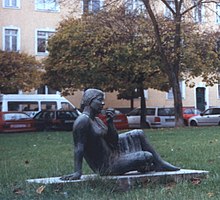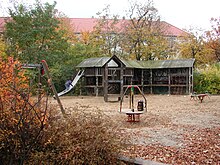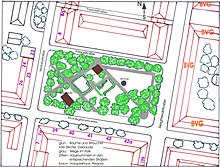Freiaplatz
| Freiaplatz | |
|---|---|
| Place in Berlin | |
 View of the Freiaplatz from the northwest |
|
| Basic data | |
| place | Berlin |
| District | Lichtenberg |
| Created | 19th century |
| Newly designed | 20th century |
| Confluent streets |
Siegfriedstrasse, Freiastrasse, Wotanstrasse, Rüdigerstrasse |
| use | |
| User groups | Pedestrians , cyclists |
| Technical specifications | |
| Square area | 13,000 m² |
The Freiaplatz in Berlin district of Lichtenberg is one with many old trees lined park, which is limited by the Siegfriedstraße, Freiastraße, Wotan Street and Rüdigerstraße and has existed since about 1900's.
history
1900-1945
The square is around 1.3 hectares and had to be kept clear due to the fire and safety regulations for the residential development that took place here between 1896 and 1930. By resolution of the Berlin city council , these simple open spaces were soon turned into decorative areas by planting deciduous trees such as chestnuts, oaks, linden, maple and bushes or by integrating monuments and fountains. A quarter of the open space treated here has now been planned as a children's playground and partitioned off by means of hedges and low iron fences. The name of the square appears for the first time in 1910, when it was still written as Freyaplatz .
The square was named after the Nordic goddess Freya , with which the name of the square fits into the surrounding street names: They are all named after characters from the Nibelungen saga, which the composer Richard Wagner used as a template for various operas. That is why the entire residential area was also called Wagner's quarter by the residents .
At the end of the Second World War , in the course of the Battle of Berlin , the German Wehrmacht erected an anti-tank barrier on Freiaplatz, which was intended to stop the advance of the Soviet units, as the following contemporary witness report from April 24, 1945 shows:
“[...] At 10 o'clock in the morning the MPi fire gets stronger. From the roof of our house we see Soviet MPi riflemen coming from Siegfriedstrasse. Walking upright, they work their way along the houses. They bypass the anti-tank barrier on Freya. I feel very strange with joy [...] "
1945–1974

The playground contained sandboxes and two metal climbing poles about five meters high. Another area of the park was a meeting place for pensioners and housewives: there were wooden benches around the trees and sometimes there were reed roofs above them. The remaining half of the square was a rectangle with a lawn and flowerbeds, the gravel path leading around was also inviting with benches to linger. A few smaller, stable works of art were also set up, such as the cast sculpture shown in the picture, which found a new place after 1975 on the open lawn in front of the then Josef Orlopp School on Rüdigerstrasse. (The allotment garden complex Roederaue was removed for the construction of the school and some multi-storey residential rows .) Christa Sammer's reclining (also girl with apple ) was also removed from this lawn during the renovation work carried out in the early 2010s (see picture). Then she got a place in the Nibelungen Park .
1975-1994
During this period, the children's playgrounds were redesigned, especially the climbing poles were dismantled. See-saws and swings were added to the sandboxes. The senior citizens' meeting place was also changed: the thatched roofs had to be removed, concrete tables were set up at the corners of the space and solid stone benches and stools were placed all around. Domino players, skat players and beer drinkers met here on summer evenings. The path between Freiastrasse and Rüdigerstrasse was paved with paving slabs.
A new path was laid diagonally across the previous lawn and flower area, on which the sculpture Mother and Child was erected in 1984 , designed by the sculptor Sabina Grzimek in 1976–1981 and dedicated to the resistance fighter Liselotte Herrmann . The sculpture was supplemented by a plaque in 2020.
After 1995
After the political change , Lichtenberg came under the jurisdiction of the Senate as a district . Reconstruction measures with narrower paths were initiated for the Freiaplatz, earlier small animal figures at the corners of the lawn were implemented. Two playgrounds for different age groups were added: a sand playground with a wooden bridge and a ball playground. New lawns as well as newly planted hedges and numerous new benches completed this change. At the end of the large lawn, a metal pergola invited people to linger and “take a breath”. The redesign cost 910,000 marks (adjusted for purchasing power in today's currency: around 653,000 euros). However, the pergola became more of a meeting place for drinkers and was therefore removed in the following years.
Transformation in the 21st century
In 2011/2012 there were criticisms of the current design of the square, which did not offer a particularly high quality of stay. Another renovation, which was supposed to defuse the conflicts between different age groups, walkers and dog owners, has now been incorporated into the district budget and into the Fund for Urban Redevelopment East and West for 2013 . In a first citizens' forum on February 23, 2012 in the district center of Alt-Lichtenberg, the wishes and designs of a landscape planner under the direction of the district councilor for urban development, Wilfried Nünthel, were presented and discussed. The former rectangular lawn area was to be restored, the two spatially separated playgrounds were to be combined, table tennis tables were to be set up and playgrounds were to be created. At the special request of the children, raised play platforms were provided.
On August 20, 2013, following the corresponding renovation plans, the square was reopened with a ceremony. The above suggestions were implemented as far as possible by the commissioned landscape architecture office Thomas Michael Bauermeister . The existing climbing frame was retained and a tree house was added. For the younger children there was a small climbing frame with a slide in the same area, the previous separate toddler area was given up. There is now a seating area for seniors under the old chestnut trees. The total renovation costs amounted to around 240,000 euros.
Edge development around the Freiaplatz
The listed houses in Rüdigerstrasse 39-42a, directly on the south side of the square, which were built between 1938 and 1940, are particularly noteworthy. The U-shaped wing begins at Wotanstrasse 7 / 7a and ends at Siegfriedstrasse 199. The residential buildings are designed with clinker-framed house entrances with figurative decorations above the entrances and with protruding staircase windows.
The non-profit building and settlement cooperative Postheimstätte eG opened a residential complex in the street area Rüdigerstrasse / Wotanstrasse (on the western edge of Freiaplatz) with 89 residential units. These consisted of 2- to 2½-room apartments with kitchen and bathroom, plus a small piece of shared garden land on the courtyard side and a shop on the corner.
To the east of the square, on Siegfriedstrasse, there are two blocks of houses painted orange and yellow. These are company apartments built by the architects Grisebach & Rehmann for the non-profit Heimstättengesellschaft der Berliner Straßenbahn GmbH, later BVG, in the 1930s. They were reserved for the tram operators at the nearby depot in Siegfriedstrasse . The northern block was equipped with the first central heating. Both blocks each form a large green inner courtyard, the area of which is about half the size of the Freiaplatz. These courtyards are included in the garden monument list of the city of Berlin. The courtyard design, in the first courtyard with a cast metal fountain bowl on an octagonal, three-step stair landing, at the edges of which eight naked children are having fun, comes from the garden architect Albert Brodersen . The BVG blocks are under monument protection .
In Freiastraße, north of the square, there is a block of houses , which also surrounds a large green courtyard, in the middle of which a hill lined with poplars, as well as bushes and benches invite the neighbors to meet up. One house in this building block (house number 8c) was completely destroyed by bombs at the end of the Second World War and was rebuilt true to the original around 1954. The square of houses is also included in the Berlin list of monuments.
A memorial plaque for the anti-fascist resistance fighter Erich Rohde , who lived here , has been located at Wotanstrasse 7 since 1973 .
Small shops were located in several corners of the perimeter development until around 1960: a soap shop, a milk shop, a bakery and a local bar. The bakery and the beer bar survived until the 2010s.
Web links
- Freiaplatz. In: Street name lexicon of the Luisenstädtischer Bildungsverein (near Kaupert )
Coordinates: 52 ° 30 ′ 58 ″ N , 13 ° 29 ′ 52 ″ E
Individual evidence
- ^ Military Publishing House of the GDR , 1985, p. 45.
- ↑ Mother with child (dedicated to the resistance fighter Liselotte Herrmann 1909-1938) on bildhauerei-in-berlin.de
- ↑ Memorial plaque for the resistance fighter Liselotte Herrmann. Press release from the Berlin-Lichtenberg district office, June 22, 2020.
- ↑ A new green island with a suspension bridge - Freiaplatz on Siegfriedstrasse has been redesigned . In: Berliner Zeitung , August 21, 1995.
- ↑ Citizens' forum for the redesign of Freiaplatz met with great interest. Lichtenberger Platz will be redesigned in 2013 with funds from urban redevelopment on stadtentwicklung.berlin.de; accessed November 28, 2012; accessed on January 8, 2016.
- ↑ In the shadow of the chestnuts. In: Berliner Woche , Lichtenberg-Nordost edition, August 21, 2013, p. 3.
- ↑ a b The architectural and art monuments of the GDR , Volume II, p. 192/193.
- ^ History of the Postheimstätte ( memento from November 21, 2012 in the Internet Archive ) on the Postheimstätte website, accessed on September 15, 2012.
- ↑ Entry in the Berlin state monument list: BVG blocks
- ↑ Entry in the Berlin State Monument List: Wotanstrasse / Gotlindestrasse / Siegfriedstrasse / Freiastrasse blocks





